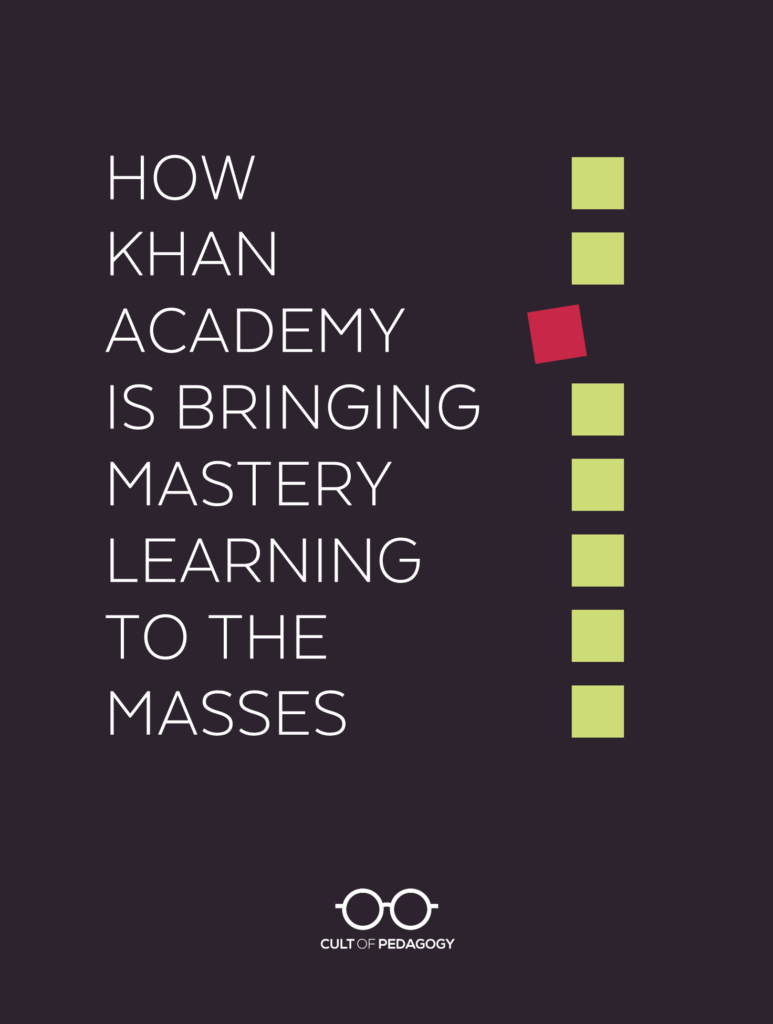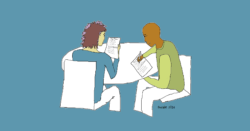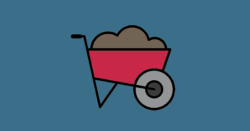
Listen to my interview with Sal Khan (transcript):
Sponsored by Pear Deck and NewseumED
We live in a time when a person can learn just about anything online. And when it comes to creating free instructional videos, Khan Academy has been leading the pack for the last decade, starting first with math videos, then branching out to include tutorials on science, computer programming, history, economics, and even grammar.
Recently, Khan has added a new layer to its platform that could really be a game-changer for all of us: the Mastery System. This system allows students to go beyond cherry-picking videos and instead take full courses, measuring their progress as they go, earning mastery points, reaching new skill levels, and completing challenges.
In our podcast interview, founder Sal Khan explained that this capability has been a goal since Khan Academy’s inception; it just took time to get it into place.

“Arguably it’s the oldest way of learning,” he said, “that you should learn at a pace that’s comfortable for you and then master concepts as you go on. Benjamin Bloom famously coined this in the ‘80s in his famous 2 Sigma study where he showed that if students are able to learn at their own time and pace in a mastery learning framework—which he defined as a framework where if the student’s at 70 percent or 80 percent correct, they should have as many chances as necessary to get to 90 percent-plus correct—that the same student at the 50th percentile could now be two standard deviations higher than that. And that was a big seminal study. It’s taught in ed schools. Everyone knows about it. No one really intellectually disagrees with it.”
Sounds about right: Most teachers would agree that differentiating instruction for students has always been the ideal, but few have ever figured out how to make it happen on a large scale.
“The issue is the pragmatic,” Khan says. “How do you implement it?”
With the new Mastery System, Khan is making it happen, and they’re making it free and accessible to anyone who wants it. Here’s an overview of how the system works:
A Supplement, Not a Replacement
It’s important to note here that no digital learning program can replace many of the experiences students should be having in our classrooms. A rich, robust, empowering education gives students regular opportunities to talk with each other, actively problem-solve with real-world tasks, collaborate on multifaceted projects, impact their communities, and wrestle with life’s big questions. These need to be designed and facilitated by live human beings who build relationships with students.
With that being said, platforms like Khan Academy can effectively take over some of our instructional tasks—like differentiating lessons based on student readiness, assessing individual skills, and assigning tasks to fill gaps—so that we can focus our time on planning and implementing those activities that build relationships and engage students at higher levels.
No one agrees with this sentiment more than Khan himself.
“Teachers need better information so that they can focus their efforts,” he says. “Students need better feedback, and they need to be able to adjust to their pacing. We need ways for class time to be more active and human, so that you can have more interaction, not less.”
“It’s more valuable for a teacher to be able to do that human intervention than to have to spend hours every night grading and assigning. So that’s where the technology’s very valuable. If a student is confused on something, and if a hint on a problem or an on-demand, three-minute video can unblock the student, great. That allows the teacher to have more capacity to either do a deeper intervention with that student, a kind of focus on the social emotional side, or do high-order tasks in the classroom, projects, simulations, etc.”
Even a Little Makes a Difference
You might not be ready to completely revamp your instruction in order to add in something like Khan’s Mastery System. The good news is, you don’t have to. Schools that are doing just a little bit of mastery learning practice each week are seeing impressive results. In a study where students consistently did 30 to 60 minutes of mastery learning practice every week, student growth in math was 33% higher than those who did less than 15 minutes per week.
“Teachers are telling us, hey, this feels very doable,” Khan says. “Every teacher I talk to, they’re telling me, look, I know I have children in my room who are not ready for the standards I need to cover. But I need to cover them. And I also know there are some kids in the room who might already know some of those standards, but I still have to cover those standards. So they’re kind of stuck between a rock and a hard place.”
With Khan’s Mastery System, teachers can tackle the differentiation problem without having to abandon their need to cover the required curriculum.
“There’s a way that we can start to have a little bit of our cake and eat it too,” Khan explains. “Maybe three or four days you do more of a traditional model, so you can ensure that coverage is happening, that everyone is having exposure to grade level material, but one class period a week can be focused on that personalized practice. “
Available Courses
The Mastery System is still pretty new, so it’s not available for all of Khan
Academy’s courses. Currently, teachers can access the Mastery Learning framework for the following courses:
- All math courses from kindergarten through college
- Physics and Biology
- AP U.S. Government and Politics
- Microeconomics
- Macroeconomics
All of these are also available in Spanish ates.khanacademy.org. In the upcoming months and years, more courses will be added.
Raising the Bar for Everyone, Everywhere
Khan sees tools like the Mastery System as part of a larger shift in history.
“I think we’re at a unique opportunity right now,” he says. “If 400 years ago you went to Western Europe and you saw who’s literate, you would have seen about 15 percent of the population knew how to read. And I suspect that if you asked someone who did know how to read, say a member of the clergy, what percentage of the population think is even capable of reading, they might have said maybe 30 percent.”
“But you fast forward now, you know it would have been a widely pessimistic prediction. Pretty close to 100 percent can read, and that’s because of mass, free, public education that happened in the 18th and 19th centuries.”
“That was the industrial revolution. Now we’re at another inflection point in history. Now people talk about what’s going to happen with 21st century: Labor is facing threats from automation and globalization. How do we get more kids to be in that top of that pyramid and that creative class, to help push forward the frontiers of medicine and science and art?”
“And I think if I ask a lot of people today, how many people would think are capable of being, contributing to cancer research, they might say, maybe optimistically 10 percent? But I think that’s kind of similar blinders on. And I genuinely believe that the task at hand, it’s not just nice to have. We want to work with educators around the world to figure out how we get to where we can shock ourselves in an optimistic way that most people are going to be able to participate in the fullest way possible in society and advance what we are as a species together.”
To get started with the Mastery System, visit KhanAcademy.org.
Join our mailing list and get weekly tips, tools, and inspiration that will make your teaching more effective and fun. You’ll get access to our members-only library of free downloads, including 20 Ways to Cut Your Grading Time in Half, the e-booklet that has helped thousands of teachers save time on grading. Over 50,000 teachers have already joined—come on in.





I have had great success with Khan Academy. Incredible program, my kids like it. I have lined it up with the lessons I am teaching, using it to strengthen skills so they can learn new skills, and practice. My students math confidence goes up. They take note, they look back at notes. Both my para and I record time spent on the program daily, we record masteries, and we have kids keep a record.
You can’t just turn them loose, (although I did the first year) and not every kid will have the work ethic to succeed, but with a little organization, aligning it to the topics you are teaching, this works incredibly well.
Hi, if you ever come up with a tutorial on how you and your para manage all of this, please post. Thanks!
Very nice! Thank you! And his comment at the end was amazing! Very well spoken Sir!!
Jennifer, Thanks for publishing this excellent interview.
Every teacher should should know what Khan Academy has to offer so that they can make an informed decision about how Khan might be put to productive use in their classroom.
Traditionally students have a fixed period of time to learn a topic before a test, which delivers varied outcomes (which we call grades).
Mastery Based Learning flips the constraints. The outcome is fixed – every student is expected to *master* every topic, but the time required for mastery varies from student to student.
Once you see mastery based learning in action, you’ll wonder why we settled on a system that allows students to progress even though may have have failed to understand up to 40% of the material. You wouldn’t want to build your house on a foundation which was missing up to 40% of its structure, and you can’t progress to higher level math if you have big gaps in your understanding of the underlying mathematical foundations.
Using Khan, Students get a concrete sense of progress for their efforts. Prove mastery of a topic and you get to move on immediately (not after the quiz on Friday). Having trouble understanding a concept? Not a problem – take the time you need to understand it before moving on (without the demoralizing experience of getting an “F”).
As students use Khan to learn, practice and master new topics, teachers have immediate visibility into which topics their students have mastered and which topics they are struggling with – without requiring the time to create, administer, and grade more tests.
Some teachers choose to “flip the classroom”, using Khan as “homework” so students are introduced to new concepts at home using Khan, allowing them to replace the classroom “lecture” with time for creative group problem solving using the new concepts.
The effectiveness of master based learning has been known for many decades, but the time and energy required to implement it made it cost prohibitive. Now teachers can bring mastery based learning into their classrooms for free (thanks to Khan) without taking on a bigger workload.
Thank you for sharing Jenn!
This is such a great resource and having it freely available to students provides opportunity for learners to have the practice they need to achieve mastery in different areas – and Khan has always done a lovely job explaining numeracy concepts in a different way.
Integrating technology into the classroom also means that students can have access to intervention when resources are low in schools, and that concepts may be explained differently than the classroom teacher does. I love that the mastery courses are self-paced and focused on what the learner has learned…. and the areas they still need to master.
I plan to look more into this resource since reading your article – thank you again!
Roberta
Glad you enjoyed, Robert – thanks for sharing!
Great podcast! I teach a Self-paced AP Economics class at the Singapore American School that is a form of mastery learning using a blended approach. I’m in my fifth year of teaching this course. It has been quite successful at our school. Online videos like those on Khan Academy made this possible. I liked the podcast you did with Sal Khan and thought it highlighted the extent to which technology is making mastery learning a practical choice now for teachers. Here’s the link to my Self-paced AP Econ Website: https://sites.google.com/site/mrhopkinssocialstudieshome/self-paced-ap-ecoomics
This podcast was right on time for me! As an academic coach I am using Khan in 2 ways. First, I use it as enrichment for students who are performing “high” on grade level math. The kids love having their own multi-age Math Club with other students who have similar interests.
After hearing this podcast I took the results of a standardized test our district administers 3 times a year called-NWEA MAP. I provided the kids with their Student Progress Report and had them identify an area that they needed to work on and from their created personalized Mastery lessons using Khan. Stay tuned for results!! The number one factor here is this-as teachers we need to select a certain number of online tools that we will interact with along with students. I have chosen to interact with Khan and students are showing growth. Khan is user friendly and other expensive online companies should look at the ease of assigning lessons and viewing data. Good job and Thanks!
Hi Consuelo,
Thanks for sharing your process with the student progress report. I recently read Achieve the Core’s article on using data binders
https://achievethecore.org/aligned/using-data-binders-increase-student-independence/
so I’m wondering how I could use student goal setting and data binders.
Hi, I created a video that explains the effectiveness of worked examples in Math. It really developed my understanding of why Math videos are useful tools to use in class.
https://drive.google.com/file/d/1GLIqKa1WbeYsitRC_la5qT-obfKACiMf/view?usp=sharing
Thank you for this video. Finding the support for using video as a tool in learning, let alone math learning, is very useful. I know my colleagues struggled with math and having to teach remotely and played with different ways to facilitate the learning; videos included! This will be a useful tool to help promote technology use in math class.
I agree, Math learning and teaching for many is very challenging especially for those who are not good at it. Like you I think Khan academy can really help in terms of mastery of some concepts. I think the ability to watch a “tutorial video” and do some Online practice will help students succeed either independently or with the support of the teacher. It also takes a bit of strain off the teachers back, they don’t need to recreate digital lessons that are already out there.
Awesome post, thanks for sharing.
Khan is a great program to implement in Math class. Can someone give me advice with how to make using this program exciting? I am new to teaching math and when I mention Khan, I get moans and groans. I am not sure how this program was used before me.
Hi Keith,
It’s hard to say why your students seem to have a less than enthusiastic response, so if you haven’t already, I’d go ahead and just ask them. This may give you the insight you need to validate their concerns and then communicate how you plan to intentionally and purposefully utilize the resources. My experience has been that when kids respond with moans and groans, they either perceive the assignment as busy work or something that’s not meeting their needs – could be they’ve been asked to do things they’re not ready for, or they’re asked to do things they have already mastered.
Take another look at the article, particularly the parts about differentiating and using the digital resources as a supplement, not as a replacement to the curriculum. Some processes to check out that lend themselves well to self-paced learning and differentiation are flipped learning and hyperdocs. Kahn resources would work well with these processes. Hope this helps!
Khan Academy is awesome, I am using it with my 5th graders and just decided to get them hooked up with the Mastery process for individualized learning.
I am looking into doing Flipped Learning (Classroom) come September and the incorporation of pre-made videos for the at home learning environment could be very useful. I tend to make most of my own videos or slide shows, however, being able to access Khan Academy for learning tools is a nice alternative. I have used it in my classroom as a supplementary tool. This Podcast really checked off a lot of my boxes when it comes to my beliefs around teaching. Spending more time around student centred learning, collaboration, SEL and higher student engagement in their learning (the human interactions). I have been wondering how much scaffolding will need to be done to teach the students how to learn? I find that students today EXPECT (or are trained) to have everything given (step-by step) to them by the teacher (spoon fed). Plus, I would love to hear opinions on whether Self Regulated Learning strategies would need to be developed ahead of using this style of instruction? Thanks!
This hit all my thoughts as well. The podcast and article really made it seem much easier then some teachers think. Allowing students to watch tutorial videos can help front load the lesson and help when you want to do that flipped classroom And do the hands on practice And work in class instead of directly teaching. It will surely give you more time with the students. Why recreate something if it is already there? Instead you can work to develop those skills that students will need to succeed it the flipped learning. Skills like how to use the tools, how to take the initiative to watch and learn instead of being handed the right and wrong way. I think it will take a little while to get the students use to having to “figure it out” some will get use to the struggle others may need more coaching. But in the end, like you, I truly believe it will be rewarding to all.
I enjoyed reading this article and learning about Khan’s amazing free resources. I am drawn to the idea of students having the time and practice they need to achieve mastery in whatever it is they are learning. I continually struggle with when to move on with the hopes that most are getting most of what’s being taught and learning. As I look to develop a blended learning model for my elementary learners, this opportunity to individualize learning to achieve individual mastery is relevant and important.
Khan’s program fits well into my student centered curriculum design that differentiates learners and allows for choice, self-pace, and offers concrete feedback on student progress helping to boost motivation and confidence. I’m wondering what experiences others have had with different tech processes or programs that focus on some of these traits and lend themselves to a blended learning situation? Also I am interested to learn how others use Khan to supplement their curriculum and integrate it within a less traditional teaching and learning environment?
Thank you for this post. I have heard of Khan Academy, and I have seen a few videos online, but I have not implemented it in my classroom yet. After reading this blog, it seems like it is easy to implement slowly and as needed instead of needing to restructure my entire curriculum completely. I also like that I can use the material as a resource for students who need remediation or students who are advanced and need more challenging content.
Hi Amanda,
I use Khan Academy in my 3rd grade classroom and I agree that it’s an easy-to-use tool that can be used to supplement your regular curriculum. My students like the videos and it’s easy to sync to Google Classroom. I think you should give it a try!